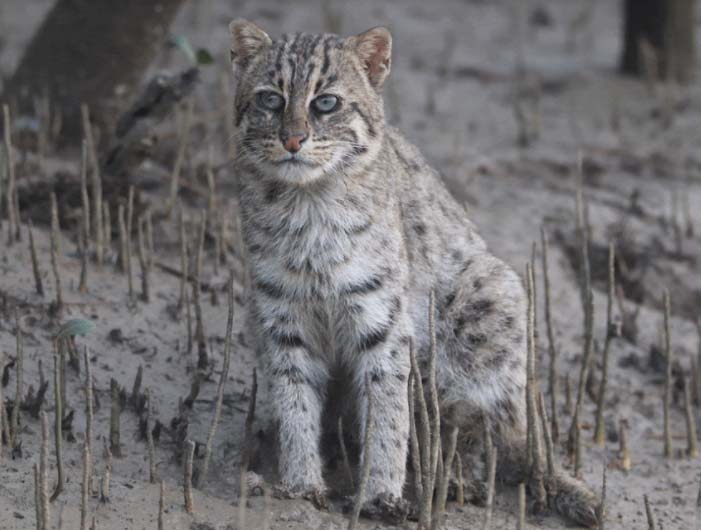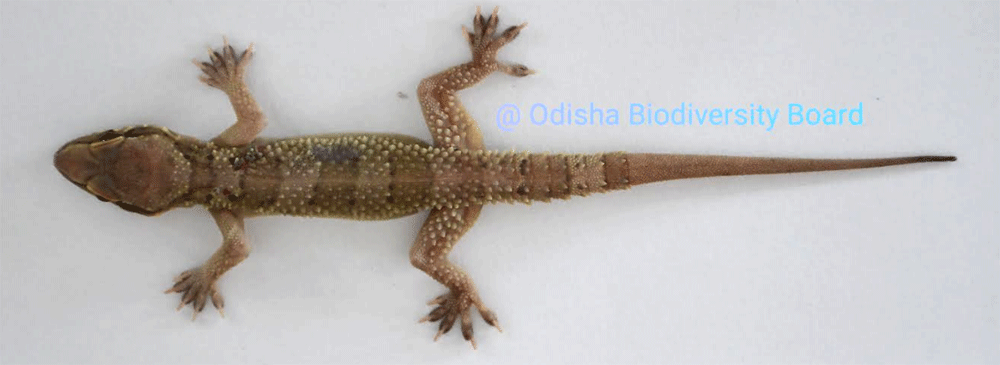Bhubaneswar: Endangered species of Lizard- Kanger Valley Rock Gecko has been located in Gupteswar in Koraput District, thanks to the efforts of the researchers of Odisha Biodiversity Board.
These reptiles are only seen in Kanger Valley National Park in Chhattisgarh and nowhere in the world, researchers say.
Rajiv Kumar, Chairman Odisha Biodiversity Board asked the researchers to move to Gupteswar for detailed study on flora and fauna.
After Mr.Kumar took over as Chairman, OBB, the organization has been taking up various research and development activities across the state.

Accordingly researchers of the (OBB) have recently completed biodiversity inventory and socio-economic studies in Gupteswar in Koraput district, said Satya Ranjan Behera, of OBB.
Located in Southern Odisha, Gupteswar is an abode for many unique and interesting flora and fauna. One of the wonderful findings of the present study is the first report of occurrence of Kanger Valley Rock (KVR) Gecko (Hemidactylus Kangerensis Mirza, Bhosale & Patil, 2017), Dr.Behera said.
The official further said that gecko is an endangered species according to the IUCN Red List. The species is endemic to Chhattisgarh’s Kanger Valley National Park (KVNP), Bastar. The current study established a new record for the species’ distribution in Gupteswar, in the southern region of Odisha.
The KVNP is situated adjacent to Gupteswar PRF separated by the perennial Sabari River. This makes an interesting occurrence of the species in Gupteswar, he added.
The defining characteristics of the species make it different from others: Snout Vent Length (SVL): 70mm, 9 to 11 pairs of Lamellae in the right pes of hind limb and as it is a female, femoral pores are absent.
The dorsal side of the body is having four distinct broad bands between the head to the caudal region, and one band in caudal construction. Further, research is required to study the possible occurrence of the species in more parts of southern Odisha for its conservation, he added.
In fact the natural ecosystem of Odisha provides conducive environment for a wide diversity of flora and fauna. To conserve such unique biodiversity, the State has wildlife sanctuaries, National Parks, Biosphere reserves, and many reserve forests and protected forests.
In addition to these, the biological diversity Act 2002 has also provisions under section 37 to declare special fragile habitats having unique biodiversity to be declared as “Biodiversity Heritage Sites” (BHS).
In this regard, the Odisha State Government on the recommendation of Odisha Biodiversity Board has declared Mandasaru as the first Biodiversity Heritage Site and further identified three other biodiversity-rich sites like Gupteswar, Gandhamardhan, and Mahendragiri.

Earlier thanks to initiative of OBB, a rare variety of Fishing Cat has been located in Bhitarkanika National Park.
It is known that the Fishing Cat is included in the Schedule-I of the Indian Wildlife (Protection) Act, 1972 and listed as Vulnerable in the IUCN Red List of Threatened Species.
Thanks to Camera trap inside the Bhitarkanika Natonal Park and the vulnerable specie was sighted on 15 February.
Reports say that a Marbled Cat was last sighted in Phulbani forests in 1956.
Similarly, ‘The Statesman’, Calcutta of 18 April 1962, reported the occurrence of caracal in Mayurbhanj district.
Thereafter their existence has not been reported in the state. At present only six species of wild cats are reported to occur in Odisha, Researchers say.
Out of fifteen living species of wild cats found in India, eight species were known to occur in Odisha.
These are Tiger (Panthera tigris), Leopard (Panthera pardus), Jungle Cat (Felis chaus), Leopard Cat (Prionailurus bengalensis), Fishing Cat (Prionailurusviverrinus), Rusty-Spotted Cat (Prionailurusrubiginosus), Marbled Cat (Pardofelis marmorata) and Caracal (Caracal caracal).
In fact Bhitarkanika National Park houses wild animals including Fishing cats. The fishing cat is a medium sized cat that is widely but erratically distributed across the Odisha State and is strongly associated with wetlands.
It is among the six felid species that presently inhabit Odisha and like other smaller cat species its status is very poorly understood.
Apart from few recent surveys in specific locations, no intensive effort has been undertaken to assess its current distribution and threats to its persistence within Odisha.
The present study has been focused on distribution status and abundance of fishing cat in their natural habitats like Bhitarkanika National Park through camera trap exercise.
The camera trap is an important and appropriate conservation tool to study the animal behavior also, said a Researcher of OBB.
OBB has decided to go for more research projects in the state as Odisha is rich in Biodiversity, said a senior official of the Board


